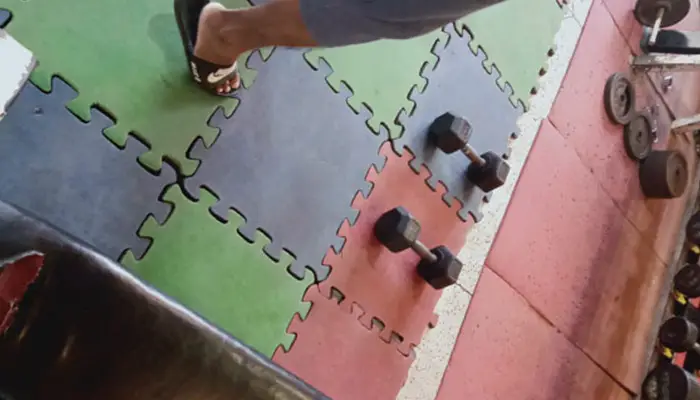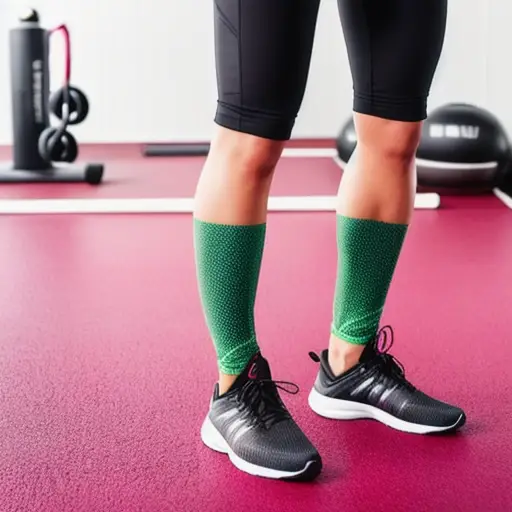How Thick Should a Rubber Gym Floor Be? Gym Flooring Ideas

A rubber gym floor is a great investment for any fitness enthusiast. But how thick should a rubber gym floor be?
A rubber gym floor should be thick enough to protect the athletes and equipment from impact, but not so thick that it becomes a trip hazard. The thickness of a rubber gym floor depends on the type of sport or activity that will be taking place on the floor. For example, a floor for weightlifting would need to be thicker than a floor for gymnastics.
Not only does it provide a safe and slip-resistant surface for working out, but it also absorbs impact and noise, making it ideal for home gyms or other areas where space is limited.
Why Rubber Gym Flooring?
If you’re looking for a durable, safe, and eco-friendly flooring option for your home gym, rubber gym flooring is a great choice. Rubber gym flooring is made from recycled tires and other rubber products, so it’s an environmentally friendly option. It’s also slip-resistant and shock-absorbent, making it a safe choice for your home gym.
Rubber gym flooring is available in tiles or rolls, and can be installed over any existing flooring.
BTW, you can also read about Reinforce Floor For Home Gym here.
How Thick Should Exercise Mats Be?
When it comes to working out, comfort is key. That’s why having the right exercise mat is so important. But with so many different types and thicknesses of mats on the market, how do you know which one is right for you?
The general rule of thumb is that the thicker the mat, the more cushioning and support it will provide. If you’re doing a lot of floor work or high-impact exercises, a thicker mat will help protect your joints and prevent injuries. If you’re doing gentler exercises, a thinner mat may be all you need.
Here are a few things to keep in mind when shopping for an exercise mat –
The type of activities you’ll be doing: If you’ll be mostly doing floor work or high-impact exercises, go for a thicker mat (at least 1 inch). For yoga or other low-impact activities, a thinner mat should be fine.
Your budget: Thicker mats tend to be more expensive than thinner ones, so if cost is a factor, opt for a thinner mat. You can always add additional padding if needed.
Portability: If you plan on taking your mat with you to the gym or on vacation, choose one that’s lightweight and easy to carry. A thicker mat may be too bulky to lug around.
How Thick Do You Want Gym Flooring?

The thickness of your rubber gym floor will depend on several factors, including the type of equipment you plan to use, the intensity of your workouts, and the amount of foot traffic in the area.
For example, if you plan to use heavy weights or exercise machines, you’ll need a thicker floor to protect against damage. Likewise, if you have a lot of foot traffic in your workout area, you’ll want a thicker floor to minimize wear and tear.
Generally speaking, most rubber gym floors are between 1/4 inch and 1/2 inch thick. However, there are some specialized floors that are even thicker – up to 3/4 inch – for extra durability.
When choosing the right thickness for your needs, be sure to consult with a professional installer or fitness expert to get the best advice for your situation.
Another thing to consider is the subfloor. If you have a concrete subfloor, you will want to make sure that the thickness of your gym flooring is enough to provide some cushioning and prevent cracking. Finally, you will also want to take into account any height restrictions that may be in place.
Depending on the building, there may be a limit on how thick the floor can be. With all of these factors in mind, you can start to narrow down what thickness would work best for your space and needs.
Is 8Mm Rubber Flooring Good?
this answer may depend on what you are using the rubber flooring for. Some pros of 8mm rubber flooring include that it is easy to install, durable, slip-resistant, and has sound-dampening properties. It is also eco-friendly and hypoallergenic.
However, some cons to consider include that it can be more expensive than other types of flooring, and it may not be as comfortable to stand on for long periods of time.
When deciding if 8mm rubber flooring is good for you, consider your needs and budget. If you need a durable, slip-resistant floor that will also deaden sound, then 8mm rubber flooring may be a good option for you.
However, if you are looking for a cheaper option or one that is more comfortable to stand on for long periods of time, then there are other options available.
Is 15Mm Gym Flooring Good?
There are also a few issues to look at when it comes to deciding if 15mm gym flooring is good for you. The first thing to think about is the thickness of the flooring. If you have a thicker gym floor, then it will be more durable and last longer.
However, it will also be more expensive. Another thing to consider is the type of material that the flooring is made out of. Gym floors are typically made out of either rubber or vinyl.
Rubber floors are more durable and easy to clean, but they can be more expensive. Vinyl floors are less durable and require more maintenance, but they tend to be less expensive. Ultimately, the decision of whether or not 15mm gym flooring is good for you depends on your individual needs and budget.
8Mm Vs 3/8 Inch Rubber Flooring
When it comes to choosing a rubber flooring for your home or business or for exercise, one of the most important considerations is thickness. The two most common thicknesses for rubber flooring are 8mm and 3/8 inch (10mm). So, which one is right for your exercise?
There are a few things to consider when deciding between 8mm and 3/8 inch rubber flooring. First, think about the area where the floor will be installed. If it’s a high-traffic area like a gym, you’ll want to choose a thicker option like 3/8 inch.
This will help to prevent wear and tear over time. Another thing to consider is the look and feel of the flooring. If you want a softer, more cushiony feel underfoot, go with 8mm.
If you prefer a firmer surface that’s still comfortable to walk on, go with 3/8 inch. Finally, think about your budget. 8mm rubber flooring is typically less expensive than 3/8 inch options.
However, keep in mind that thicker floors may last longer and may require less maintenance over time so they could end up being a better value in the long run.
1/2 Inch Rubber Gym Flooring
Rubber flooring is available in a variety of thicknesses, but 1/2 inch is a popular choice for many reasons. One of the main benefits of 1/2 inch rubber flooring is that it’s extremely durable.
This thickness provides ample cushioning and support, while also being able to withstand heavy traffic and weightlifting equipment. Rubber flooring is also slip-resistant and easy to clean, making it a great option for gyms where hygiene is a priority.
Another advantage of 1/2 inch rubber flooring is that it’s relatively inexpensive compared to other options like carpet or hardwood.
And because it’s so easy to install, you can usually do it yourself without having to hire a professional. If you’re looking for an affordable and durable flooring solution for your home gym, then 1/2 inch rubber flooring may be the perfect option for you!
1” Thick Gym Flooring
This type of flooring is becoming increasingly popular in gyms and other fitness facilities due to its many benefits. Here, we’ll go over some of the key features of 1” thick gym flooring and why it’s such a great option for your facility.
One of the biggest advantages of 1” thick gym flooring is that it provides superior cushioning and impact absorption. This means that it’s much easier on your joints and muscles when you’re working out, which can help reduce the risk of injuries. Additionally, the thicker construction also makes this type of flooring more durable and resistant to wear and tear.
Another great benefit of 1” thick gym flooring is that it can help reduce noise levels. This is especially important if you have multiple fitness activities going on at the same time or if your facility is located in a busy area. The thicker construction helps to dampen sound, making it more comfortable for everyone using the space.
Best Rubber Flooring for Home Gym
If you’re looking for the best rubber flooring for your home gym, you have a few different options to choose from. Depending on your budget and the look you’re going for, you can find the perfect rubber flooring to suit your needs. One option is interlocking rubber tiles.
These are easy to install and come in a variety of colors and designs. They’re also durable and slip-resistant, making them ideal for high-traffic areas like home gyms.
Another option is rolled rubber flooring. This type of flooring is available in sheets or rolls, and it’s easy to install yourself. Rolled rubber flooring is also slip-resistant and very durable, making it a great choice for home gyms.
Finally, if you’re looking for something a little more luxurious, consider tile or stone floors with RubberGard underlayment. This type of flooring provides excellent sound dampening and insulation, making it ideal for home gyms. Plus, it’s beautiful and easy to clean!
Foam Vs Rubber Gym Flooring

If you’re considering gym flooring for your home or commercial space, you may be wondering what the difference is between foam and rubber. Here’s a quick rundown of the pros and cons of each type of flooring to help you make the best decision for your needs.
Foam Flooring
[su_row][su_column]
[su_box title=”Pros” box_color=”#3db394″ title_color=”#fff” radius=”0″]
[su_list icon=”icon: check-square-o” icon_color=”#3db394″]
Foam is a softer material than rubber, so it’s more comfortable to stand on for long periods of time. It’s also easier on your joints when you’re doing high-impact workouts like running or jumping. Foam flooring is also much quieter than rubber, so it’s ideal if you have downstairs neighbors or want to keep your workout noise to a minimum.
[/su_list]
[/su_box]
[/su_column]
[su_column]
[su_box title=”Cons” box_color=”#d00000″ title_color=”#fff” radius=”0″]
[su_list icon=”icon: ban” icon_color=”#d00000″]
Foam is softer, but not as durable as rubber and can show wear and tear more easily. It’s also not as slip-resistant, so it might not be the best choice if you plan on using dumbbells or other equipment that could slide around on the surface.
[/su_list]
[/su_box]
[/su_column][/su_row]
Rubber Flooring
[su_row][su_column]
[su_box title=”Pros” box_color=”#3db394″ title_color=”#fff” radius=”0″]
[su_list icon=”icon: check-square-o” icon_color=”#3db394″]
Rubber is a very durable material that can withstand a lot of wear and tear. It’s also slip-resistant, so it’s a good choice for using with weights or other equipment. Rubber flooring is available in tiles or rolls, so it’s easy to install yourself.
[/su_list]
[/su_box]
[/su_column]
[su_column]
[su_box title=”Cons” box_color=”#d00000″ title_color=”#fff” radius=”0″]
[su_list icon=”icon: ban” icon_color=”#d00000″]
Rubber flooring can be quite loud, so it may not be ideal if you have downstairs neighbors or want to keep your workout noise to a minimum. It can also be hard on your joints because it’s a harder surface than foam.
[/su_list]
[/su_box]
[/su_column][/su_row]
Trainer Mr. Shovon Doing Renegade Row on Rubber Gym Flooring – Video
Conclusion
According to most experts, a rubber gym floor should be at least 3/8 of an inch thick in order to provide adequate protection and cushioning. However, some argue that a thickness of 1/2 an inch is actually ideal.
Ultimately, the thickness of your rubber gym floor will depend on personal preference and the type of activities that you plan on using it for.
FYI, here I discussed on details of installing rubber gym floor on the carpet.
Thanks for reading till the end!






